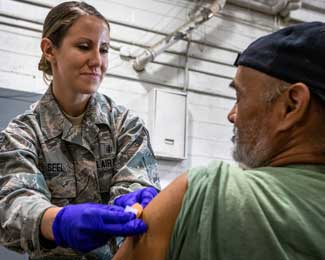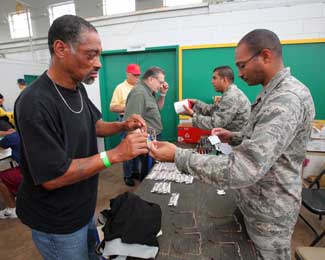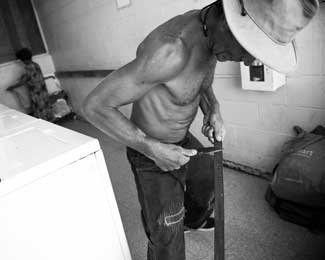VA’s Work to End Veteran Homelessness Is a Nationwide Model. Can It Translate for Civilians?
In late January, groups of volunteers around the country set out on foot and in vehicles in search of individuals experiencing homelessness. The goal: Get a sense of how many people are living outdoors or in shelters in their own communities and the nation at large.
Jon Johnson, a social worker and director of homeless programs with the San Francisco Veterans Affairs Health Care System, has long been among those bundled beneath winter layers during the Point-in-Time count, the annual documentation of the hundreds of thousands of homeless people around the nation.
Despite more than two decades of working in homelessness, the sight of anyone—veteran or not—lying on the street or curled on a park bench comes as a shock. Yet it is part of what drives him and others in his organization to work toward ending veteran homelessness—“keeping,” Johnson says, “the two words ‘veteran and ‘homeless’ out of our mouths.”

U.S. Air Force Tech. Sgt. Melissa A. Seel, aerospace medical technician, 177th Fighter Wing, New Jersey Air National Guard, puts an adhesive bandage on a homeless veteran during the Sgt. 1st Class Robert H. Yancey Sr. Stand Down at the National Guard armory in Cherry Hill, New Jersey, Sept. 27, 2019. Photo by Master Sgt. Mark Olsen, courtesy of the New Jersey National Guard.
The efforts have paid off. Over a 12-year stretch that ended in 2022, the population of unhoused veterans dropped by more than half. Although that trend reversed over the last year—rising 7.4% from 2022 to 2023—it was still lower than the 12% overall increase in homelessness.
Part of the long-term success of reducing the number of unhoused veterans is the Veterans Affairs’ pledge to end it—as well as the funding to cover the costs of that goal.
Coordinated efforts between local, state, and federal agencies that can act as safety nets; screening protocols to identify veterans at risk for homelessness; billions of dollars in federal money; and the prioritization of veteran homelessness by lawmakers across political parties has also contributed to that success. To date, 83 communities and the entire states of Connecticut, Delaware, and Virginia have effectively ended homelessness among veterans.
But that level of progress hasn’t been replicated in the homeless population at large. This year’s increase in overall homelessness signifies the largest jump since the federal government began counting in 2007.
A year after the count began, in 2008, the U.S. Department of Housing and Urban Development launched the HUD-VA Supportive Housing program, which has provided housing vouchers and supportive services for thousands of homeless veterans every year since its establishment.
The scale of resources for housing homeless veterans is far closer to the actual need when compared to any other subgroup of unhoused individuals, such as homeless families or homeless youth, says Ann Oliva, CEO of the National Alliance to End Homelessness who worked for HUD for a decade and helped design the supportive program for veterans.
While the program doesn’t completely meet the needs of all unhoused veterans, she says, “it’s close.”
That stands in stark relief to the non-veteran population.
Only 25% of people in households eligible for HUD-funded rental assistance receive it. Three out of four “extremely low-income” households don’t have the housing assistance they need, putting them at risk for homelessness.
The VA’s approach to veteran homelessness offers a model for how to decrease homelessness nationwide, says Dr. Margot Kushel, director of the San Francisco Center for Vulnerable Populations and the Benioff Homelessness and Housing Initiative at the University of California, San Francisco. But that model also benefits from billions in federal money, and that’s where civilian programs hit a wall.
‘VA Is Driving the National Reduction in Veterans Homelessness’
About 22 out of every 10,000 veterans have experienced homelessness, HUD estimates. And in addition to efforts like the Point-in-Time count, the VA has worked extensively to find unhoused veterans over the last 12 years, including through outreach workers who hit the streets and screening tools at outpatient clinics and hospitals.
In January, VA announced it had housed 46,500 veterans in 2023—exceeding its goal of 38,000. And nearly all of the individuals VA housed retained their housing and didn’t cycle back out on the streets. Of the veterans who did lose housing—about 1,500—VA was able to begin helping about 93% with housing within the calendar year. Both the HUD-VA housing program and Supportive Services for Veteran Families, a program for veterans at risk of losing housing, have been critical tools in cutting homelessness.
Award-Winning Journalism in Your Inbox
Only after a homeless veteran is identified can assistance begin, says Monica Diaz, executive director of the Veterans Health Administration Homeless Programs office. VA case workers or other staff determine “the best next step in terms of referral for the homeless programs,” she says. That could include a housing voucher, employment help, mental health treatment, or all of the above.
In cases where VA can’t provide the needed resources, a local veterans service organization that works closely with VA often steps in.
“The VA is driving the [national] reduction in veterans homelessness,” says Sam Tsemberis, founder of the Pathways Housing First Institute—the organization that created the Housing First model, which prioritizes housing without conditions, such as sobriety, and includes supportive services. VA adopted the model more than 10 years ago.
VA acts as a central hub, coordinating with HUD for housing vouchers, as well as with community homeless service providers for supportive services to create stability for the veterans, Tsemberis says.
On the civilian side, without immediate access to vouchers and other resources, cities trying to reduce homelessness must navigate a patchwork.
“You’re going to have to work with the outreach teams—the shelters, the business community, police, hospitals,” he says.

Public Health Officer 1st Lt. Gyasi J. Mann, right, and Bioenvironmental Engineer Senior Airman Emilio D. Gonzalez, second from right, both with the 108th Medical Group, New Jersey Air National Guard, help homeless veterans choose a pair of reading glasses during Stand Down 2012 at the National Guard Armory in Cherry Hill, Sept. 28, 2012. Photo By Master Sgt. Mark Olsen, courtesy of the New Jersey National Guard.
And there’s no guarantee all those entities operate on the same page. From screening to long-term supportive services, VA has a clear, “organized mechanism,” Kushel says. But on the civilian side, some hospital staff members don’t feel comfortable asking questions to find out if someone is homeless—leaving out a piece of the safety net.
“Many people [believe], as I do, that [screening] helps to understand the full context of people’s lives,” she says. But there’s angst amongst some medical professionals when it comes to screening because, “You bring up these really traumatic parts of people’s lives, you ask them these questions that are really upsetting, and then you have nothing to offer them,” she says.
Kushel can often only provide for non-veterans a list of shelters and feeding sites or a contact for San Francisco’s coordinated entry system, where communities track and prioritize homeless individuals.
And because there’s such a backlog in housing vouchers known as Section 8, most homeless individuals, or those at risk of becoming homeless, wait months or even years to access one.
In affluent cities, the struggle to secure low-income housing is only exacerbated. In San Francisco, when the Section 8 waitlist opened up for the first time in 10 years this past fall, local media reported that more than 60,000 applicants were expected to flood the system for 6,500 spots on a waitlist.
“I don’t think that there’s any community in the country right now that has enough of anything,” Oliva says.
The most recent 2023 Point-in-Time count reflects that. Not only was overall homelessness up, but chronic homelessness hit an all-time high. The number of families with children who were experiencing homelessness increased by more than 25,000 people from the previous year. Experts say the end of COVID-era eviction moratoriums and emergency financial assistance are in part to blame.
‘They Learned Something by the Collaboration And Working With Veterans’
Locally, communities combating homelessness have benefited from the influx of federal support for veteran homelessness, Tsemberis says. By dedicating caseworkers, housing vouchers, and outreach teams to veterans, service providers have gained a better understanding of the paths in and out of homelessness, as well as the importance of relationships in lifting unhoused people into housing and stability.
“That allowed them to deal with other people who are chronically homeless—people who had severe mental illness or other subgroups,” he says. “They learned something by the collaboration and working with veterans that wasn’t in place before.”
Still, an essential ingredient to curbing homelessness is money.
“You can’t do it without resources,” Tsemberis says.

Alex, a former Russian military operative, sharpens his knife inside a community laundromat in the Chinatown District of Honolulu, Hawaii, Aug. 15, 2016. Photo by Tech. Sgt. Brandon Shapiro, courtesy of the U.S. Air Force.
In addition to too few housing vouchers for unhoused people with low incomes, there’s also a “tremendous shortage of affordable housing,” he says. And, while veterans get caseworkers and other supportive services through the HUD-VA housing program, similar resources for civilians are often cobbled together through city, county, state, and private funding.
“Organizations have to work very hard to bring together the money,” he says. “There isn’t a well-coordinated collaboration between, let’s say, Health and Human Services and HUD, which is exactly what we would need to do at a national level to replicate what’s going on with the VA.”
Federal action to provide more housing vouchers or other subsidies is the only way to climb out of the ever-rising homelessness rates, Kushel says.
“The market is not going to solve this,” she says. “We’ve gotten too far apart from what poor peoples’ incomes are and what the housing market is.”
Oliva, with the National Alliance to End Homelessness, doesn’t see that kind of federal action happening anytime soon.
“In part, it’s because veterans are seen as worthy,” she says.
Our Journalism Depends on Your Support
In these hyperpolitical times, Congress likely won’t aggressively pursue policies that would help all 650,000 individuals who live without stable housing, Olivia says.
“The general public understands the sacrifice that people who served our country made,” she says. And because of that, there’s sympathy for the veterans whose country has failed to care for them.
But nonveteran unhoused people have complex stories—employment loss or incarceration, domestic violence or addiction—and Oliva says weaving those threads to build political will is going to be no easy task.
This War Horse investigation was reported by Anne Marshall-Chalmers, edited by Kelly Kennedy, fact-checked by Jess Rohan, and copy-edited by Mitchell Hansen-Dewar. Abbie Bennett wrote the headlines.





Comments are closed.